


Nore Stave Church (Norwegian : Nore stavkyrkje) is a stave church located at Nore in Nore og Uvdal kommune in Buskerud county, Norway. [1] [2]



Nore Stave Church (Norwegian : Nore stavkyrkje) is a stave church located at Nore in Nore og Uvdal kommune in Buskerud county, Norway. [1] [2]
Dendrochronological dating of wood samples indicate that Nore stave church was built after 1167. [3] The church was built with galleries, a chancel and cross naves – an architectural style that was unique in Europe during the Middle Ages. This style has come to be known as Nummedals-type. Decorations are from different periods. Nore is decorated with tendril and animal carvings. Animal characters featured include dragons and lions.
The church has a central mast that was originally the support for a tower, mostly likely containing church bells. The walls and ceiling of the interior are decorated with murals, among them scenes from the Bible presented as riddles. The church has been remodeled several times, with many original parts preserved. The church was partly rebuilt in the 1600s and 1700s. The chancel was replaced in 1683, and the spokes of the nave in the first half of the 18th century. The church received a new roof in 1730. Comprehensive repair was carried out in 1927.
In 1888, art historian, professor of art history, and author Lorentz Dietrichson (1834–1917) became the owner of the church. Professor Dietrichson, who played a major role in founding the Society for the Preservation of Ancient Norwegian Monuments ( Fortidsminneforeningen ), donated the property to the society in 1890. [4] [5]

Nore og Uvdal is a municipality in Buskerud county, Norway. It is part of the traditional region of Numedal. The administrative centre of the municipality is the village of Rødberg.

Hol is a municipality in Buskerud county, Norway.

Rollag is a municipality in Buskerud county, Norway. It is part of the traditional region of Numedal. The administrative centre of the municipality is the village of Rollag, although the most populated area in the municipality is Veggli. Rollag is bordered in the north by Nore og Uvdal, in the east by Sigdal, in the south by Flesberg, and in the west by Tinn in Telemark.
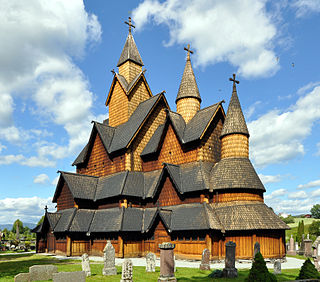
A stave church is a medieval wooden Christian church building once common in north-western Europe. The name derives from the building's structure of post and lintel construction, a type of timber framing where the load-bearing ore-pine posts are called stafr in Old Norse. Two related church building types also named for their structural elements, the post church and palisade church, are often called 'stave churches'.

Numedal is a valley and a traditional district in Eastern Norway located within the county of Buskerud. It traditionally includes the municipalities Flesberg, Nore og Uvdal and Rollag. Administratively, it now also includes Kongsberg.

Borgund Stave Church is a former parish church initially of the Catholic Church and later the Church of Norway in Lærdal Municipality in Vestland county, Norway. It was built around the year 1200 as the village church of Borgund, and belonged to Lærdal parish until 1868, when its religious functions were transferred to a "new" Borgund Church, which was built nearby. The old church was restored, conserved and turned into a museum. It is funded and run by the Society for the Preservation of Ancient Norwegian Monuments, and is classified as a triple-nave stave church of the Sogn-type. Its grounds contain Norway's sole surviving stave-built free-standing bell tower.
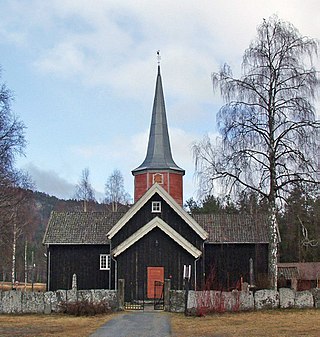
Flesberg Stave Church is a stave church located at Flesberg in Buskerud county, Norway.

Urnes Stave Church is a 12th-century stave church at Ornes, along the Lustrafjorden in the municipality of Luster in Vestland county, Norway.
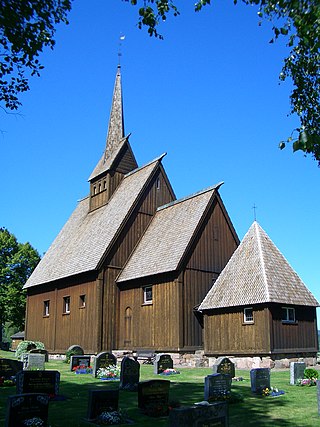
Høyjord Stave Church is a parish church of the Church of Norway in Sandefjord Municipality in Vestfold county, Norway. It is located in the village of Høyjord. It is the church for the Høyjord parish which is part of the Sandefjord prosti (deanery) in the Diocese of Tunsberg. The brown, wooden church was built in a stave church design during the late 12th century using plans drawn up by an unknown architect. The church seats about 150 people.

Undredal Stave Church is a parish church of the Church of Norway in Aurland Municipality in Vestland county, Norway. It is located in the village of Undredal, on the shore of the Aurlandsfjorden. It is the church for the Undredal parish which is part of the Sogn prosti (deanery) in the Diocese of Bjørgvin. The white, wooden church was built in a stave church style around the year 1147.

Uvdal Stave Church is situated at Uvdal in the valley Numedal in Nore og Uvdal in Buskerud, Norway. The stave church was originally constructed just after the year 1168, which is known through dendrochronological dating of the ore-pine used in the construction. The logs were not completely dry when the construction took place.

Røldal Stave Church is a parish church of the Church of Norway in Ullensvang Municipality in Vestland county, Norway. It is located in the village of Røldal. It is the church for the Røldal parish which is part of the Hardanger og Voss prosti (deanery) in the Diocese of Bjørgvin. The brown, wooden stave church was built in around the year 1250 using designs by an unknown architect. The church seats about 130 people and is built in a long church design. The church is a preserved historic museum, but it is still a regularly-used parish church that holds regularly scheduled worship services twice a month.

Rollag Stave Church is a stave church in the municipality of Rollag in Buskerud county, Norway. The church is located a few kilometres north of the centre of the village of Rollag.

Gol Stave Church is a 12th century stave church originally from Gol in the traditional region of Hallingdal in Buskerud county, Norway. The reconstructed church is now a museum and is now located in the Norwegian Museum of Cultural History at Bygdøy in Oslo, Norway.

Kvernes Stave Church is a former parish church of the Church of Norway in Averøy Municipality in Møre og Romsdal county, Norway. The old church sits along the Kvernesfjorden in the village of Kvernes, just to the north of the Kvernes Church, the present church for the parish. The white, wooden church was built in a rectangular stave church style sometime during the first half of the 14th century. The church seats about 200 people.
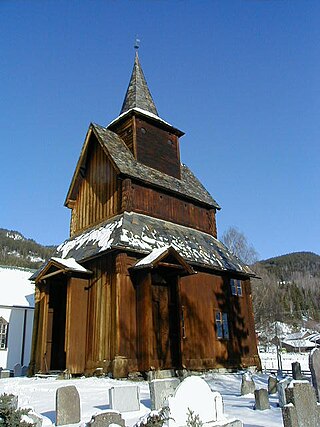
Torpo Stave Church is a stave church located in Torpo, a small village in Ål municipality in Buskerud county, Norway. Torpo is located along Norwegian National Road 7, the Norwegian national road which runs between Oslo and Bergen.

Nore is a village in the municipality of Nore og Uvdal in the county of Buskerud, Norway. It is located in the traditional region of Numedal.

Uvdal is a village and former municipality in Buskerud county, Norway. It is situated in the traditional region of Numedal and is the location of the Uvdal Stave Church.
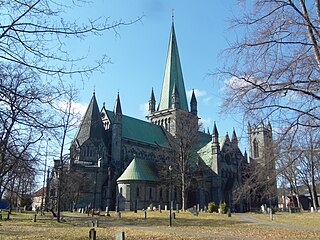
Church building in Norway began when Christianity was established there around the year 1000. The first buildings may have been post churches erected in the 10th or 11th century, but the evidence is inconclusive. For instance under Urnes Stave Church and Lom Stave Church there are traces of older post churches. Post churches were later replaced by the more durable stave churches. About 1,300 churches were built during the 12th and 13th centuries in what was Norway's first building boom. A total of about 3,000 churches have been built in Norway, although nearly half of them have perished. From 1620 systematic records and accounts were kept although sources prior to 1620 are fragmented. Evidence about early and medieval churches is partly archaeological. The "long church" is the most common type of church in Norway. There are about 1620 buildings recognized as churches affiliated with the Church of Norway. In addition, there are a number of gospel halls belonging to the lay movement affiliated with the Church of Norway as well as churches belonging to other Christian bodies. Until the 20th century, most churches were built from wood. 220 buildings are protected by law, and an additional 765 are listed as valuable cultural heritage.